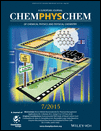 ChemPhysChem is retracting a pair of articles by a group of researchers in China and their colleagues who pieced together the work from two previously published articles.
ChemPhysChem is retracting a pair of articles by a group of researchers in China and their colleagues who pieced together the work from two previously published articles.
The papers appeared in 2012 and 2015, and were flagged by a reader whose own work had been improperly cited, according to the editor of the journal.
The 2012 article was titled “Adsorption Features of Flavonoids on Macroporous Adsorption Resins Functionalized with Ionic Liquids,” and has been cited twice, according to Thomson Scientific’s Web of Knowledge. The senior author was Duolong Di, of the Lanzhou Institute of Chemical Physics in Qingdao. According to the retraction notice:
The above article, published online on 18 July 2012 in Wiley Online Library (wileyonlinelibrary.com), and in Volume 13, pp. 3330–3339, has been retracted by agreement between the authors, the Editor-in-Chief, Greta Heydenrych, and Wiley-VCH Verlag GmbH & Co. KGaA. The retraction has been agreed due to substantial overlap with previously published material by the same authors in S. Lou, D. Di, Journal of Agricultural and Food Chemistry 2012, 60, 6546–6558, and in S. Lou, Z. Chen, Y. Liu, H. Ye, D. Di, Industrial & Engineering Chemistry Research 2012, 51, 2682–2696.
The second paper, “Analyzing the Effects of Sphere Size on the Adsorption Behavior of Flavonoids on Core-Shell Ionic-Liquid-Based Resins,” was by Di, Lou and two other researchers. Its notice reads:
The above article, published online on 19 January 2015 in Wiley Online Library (wileyonlinelibrary.com), has been retracted by agreement between the authors, the Editor-in-Chief, Greta Heydenrych, and Wiley-VCH Verlag GmbH & Co. KGaA. The retraction has been agreed due to substantial overlap with previously published material in S. Lou, D. Di, Journal of Agricultural and Food Chemistry 2012, 60, 6546–6558, and in S. Lou, Z. Chen, Y. Liu, H. Ye, D. Di, Industrial & Engineering Chemistry Research 2012, 51, 2682–2696.
The editor of ChemPhysChem told us:
We were contacted by a reader who said that some of his publications had been cited inappropriately. We followed up with the authors, who gave a reasonably satisfactory response (in the sense that they surely could have found more appropriate citations, but their reasons for choosing those particular ones seemed reasonably well-motivated). We decided that, although their response was a bit iffy, this did not warrant a correction to the article. The reader posted about this on PubPeer and a comment there mentioned that there seems to be overlap between the ChemPhysChem publication and a publication by the some of the same authors in a different journal from about three years ago. We were alerted to this by the reader who initially drew our attention to the citations. When we investigated, we realised that both the 2015 and 2012 ChemPhysChem publications showed significant overlap – figures, entire paragraphs, etc. – with two of the authors’ earlier works in different journals. When we confronted the authors (we contacted all of them), they first denied all wrongdoing, but then slowly relented (with one exception). We also contacted the editors of the two other journals, but never heard back from them.
Hat tip: Michael Fischer
Just a note that a lot of the action happened on Twitter, where I documented the original citations issue (https://twitter.com/fxcoudert/status/559828389704396801; yes, I was the “reader”) and later the “significant overlap”.
It’s also fair to note that the editor of ChemPhysChem was clearly bothered that I had posted publicly about these issues, and would have preferred things to be handled behind closed doors.
I am rather baffled by the journal. During “peer review”, how is it possible that the “peers” and/or editor(s) did not detect this (i.e., the previous papers)? The titles are quite similar – as are the authors names – and the previous papers were published in highly respected journals, so they would have easily turned up during a Google or other data base search using several of the key words and authors’ names. This case may display dishonesty on the part of the authors, but it also appears to display a lack of quality control during “peer review” by this journal. I would be curious as to the explanation the EC would offer for this serious peer/editorial lapse.
For the record:
https://pubpeer.com/publications/F47D8A92175EF42AEBE9D2CA4B4940 (2015)
https://pubpeer.com/publications/EAC96D51DAC2900C9A798845825770 (2012)
According to the article, the editor of ChemPhysChem stated: “We also contacted the editors of the two other journals [S. Lou, D. Di, Journal of Agricultural and Food Chemistry 2012, 60, 6546–6558, and in S. Lou, Z. Chen, Y. Liu, H. Ye, D. Di, Industrial & Engineering Chemistry Research 2012, 51, 2682–2696], but never heard back from them.” Both of those journals are published by the American Chemical Society.
@Query: You are right, this was an editorial lapse. However, in the time that I have worked with ChemPhysChem (a bit more than seven years now), we have had two incidents where papers were retracted, but many more where we spotted potential misconduct up front – these cases normally do not make it out into social media. Compare this to journals such as Science and Nature and I think it is celar that while editors do their best to spot these things, some papers will slip through. It should not happen, but it does. We will certainly be even more vigilant, but no system is 100% secure.
For the record, I do support that cheaters are exposed and sites such as this and PubPeer are very useful in that respect. However, because an accusation of scientific misconduct is very serious, it is important that one has the facts at hand before making public accusations. This particular case was on Twitter before the authors have been contacted and at that point it still looked like a case of poor citation selection and not full-blown duplicate publishing.
I hope this clarifies any outstanding questions about this case.